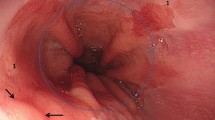Abstract
Background
Blood supply is especially weak near the gastric fundus. Making the anastomosis in this area would increase the risk of anastomotic leakage (AL). In cervical anastomosis, the gastric conduit needs to travel through the thorax. Therefore, the relative length between the stomach and the thorax is an essential factor in deciding if the poorly supplied area could be removed. This study was to explore if a small relative gastric length was a risk of cervical AL. If all other conditions are equal, could intrathoracic anastomosis be a better choice?
Methods
Patients who underwent esophagectomy with a preoperative barium swallow in West China Hospital between 2014 and 2017 were included. The length of the greater curvature and the thorax were obtained from the barium esophagogram. The ratio between the length of the greater curvature and the thorax was the relative gastric length calculated from the greater curvature (RGL-G).
Results
A total of 782 patients were enrolled in the final analysis. The cervical AL group had a significantly higher ratio of patients with an RGL-G less than 1.3 (26.7% vs. 8.9%, p = 0.003). The multivariate logistic regression proved that RGL-G less than 1.3 was a risk factor for cervical anastomotic leakage (p = 0.012). Correspondingly, RGL-G less than 1.3 was not a risk factor (6.3% vs. 14.3%, p = 0.289) in the intrathoracic anastomosis group.
Conclusions
RGL-G less than 1.3 was a new risk factor for cervical AL, but it would not be a problem for intrathoracic anastomosis.


Similar content being viewed by others
References
Ohkura Y, Shindoh J, Ueno M et al (2018) Comparison of outcome of esophagectomy versus nonsurgical treatment for resectable esophageal cancer with clinical complete response to neoadjuvant therapy. Ann Surg Oncol 25:2428–2433
Straatman J, van der Wielen N, Cuesta MA et al (2017) Minimally invasive versus open esophageal resection: three-year follow-up of the previously reported randomized controlled trial: the time trial. Ann Surg 266:232–236
Manghelli JL, Ceppa DP, Greenberg JW et al (2019) Management of anastomotic leaks following esophagectomy: when to intervene. J Thorac Dis 11:131–137
Aoyama T, Kazama K, Atsumi Y et al (2020) Clinical influence of anastomotic leakage on esophageal cancer survival and recurrence. Anticancer Res 40:443–449
Gooszen JAH, Goense L, Gisbertz SS et al (2018) Intrathoracic versus cervical anastomosis and predictors of anastomotic leakage after oesophagectomy for cancer. Br J Surg 105:552–560
Deng J, Su Q, Ren Z et al (2018) Comparison of short-term outcomes between minimally invasive mckeown and ivor lewis esophagectomy for esophageal or junctional cancer: a systematic review and meta-analysis. Onco Targets Ther 11:6057–6069
van Workum F, van der Maas J, van den Wildenberg FJ et al (2017) Improved functional results after minimally invasive esophagectomy: intrathoracic versus cervical anastomosis. Ann Thorac Surg 103:267–273
Ozawa SA-O, Koyanagi KA-O, Ninomiya Y et al (2020) Postoperative complications of minimally invasive esophagectomy for esophageal cancer. Ann Gastroenterol Surg 4:126–134
Verstegen MA-OX, Bouwense SAW, van Workum F et al (2019) Management of intrathoracic and cervical anastomotic leakage after esophagectomy for esophageal cancer: a systematic review. World J Surg Emerg Surg 4:14–17
Wang P, Li Y, Sun H et al (2019) Predictive value of body mass index for short-term outcomes of patients with esophageal cancer after esophagectomy: a meta-analysis. Ann Surg Oncol 26:2090–2103
Li SJ, Wang ZQ, Li YJ et al (2017) Diabetes mellitus and risk of anastomotic leakage after esophagectomy: a systematic review and meta-analysis. Dis Esophagus 30:1–12
Gao C, Xu G, Wang C et al (2019) Evaluation of preoperative risk factors and postoperative indicators for anastomotic leak of minimally invasive mckeown esophagectomy: a single-center retrospective analysis. J Cardiothorac Surg 14:46–53
Zhuo ZG, Shen X, Song TN et al (2020) The efficacy of ischemic conditioning in the prevention of gastroesophageal anastomotic complications: a meta-analysis. Ann Palliat Med 9:1586–1595
Saber AA, Azar N, Dekal M et al (2015) Computed tomographic scan mapping of gastric wall perfusion and clinical implications. Am J Surg 209:999–1006
Nishikawa K, Fujita T, Yuda M et al (2020) Quantitative assessment of blood flow in the gastric conduit with thermal imaging for esophageal reconstruction. Ann Surg 271:1087–1094
Ohi M, Toiyama Y, Mohri Y et al (2017) Prevalence of anastomotic leak and the impact of indocyanine green fluorescein imaging for evaluating blood flow in the gastric conduit following esophageal cancer surgery. Esophagus 14:351–359
Rice TW, Ishwaran H, Ferguson MK et al (2017) Cancer of the esophagus and esophagogastric junction an eighth edition staging primer. J Thorac Oncol 12:36–42
Nakajima Y, Kawada K, Tokairin Y et al (2020) Flexible gastric tube: a novel gastric tube formation method to prevent anastomotic leakage. Ann Thorac Surg 109:e445–e447
Zheng X, Yang YS, Hu WP et al (2020) Coniform gastric tube for end-to-end anastomosis during minimally invasive mckeown Esophagectomy. Ann Thorac Surg 109:e297–e300
van Workum F, Berkelmans GH, Klarenbeek BR et al (2017) Mckeown or ivor lewis totally minimally invasive esophagectomy for cancer of the esophagus and gastroesophageal junction: systematic review and meta-analysis. J Thorac Dis 9:S826-s833
Jezerskyte E, Saadeh LM, Hagens ERC et al (2020) Long-term health-related quality of life after mckeown and ivor lewis esophagectomy for esophageal carcinoma. Dis Esophagus 00:1–9
Peng JS, Kukar M, Mann GN et al (2019) Minimally invasive esophageal cancer surgery. Surg Oncol Clin N Am 28:177–200
Acknowledgements
This work was supported by the National Natural Science Foundation of China (Grant Number: 81672291, 31071210 to Y.-D. Lin).
Author information
Authors and Affiliations
Corresponding author
Ethics declarations
Conflict of interest
No conflict of interest was declared.
Additional information
Publisher's Note
Springer Nature remains neutral with regard to jurisdictional claims in published maps and institutional affiliations.
Rights and permissions
About this article
Cite this article
Yao, P., Zhang, Y., Li, G. et al. A New Risk Factor for Cervical Anastomotic Leakage-Role of The Relative Gastric Length in the Surgical Treatment of Esophageal Cancer. World J Surg 46, 2235–2242 (2022). https://doi.org/10.1007/s00268-022-06579-w
Accepted:
Published:
Issue Date:
DOI: https://doi.org/10.1007/s00268-022-06579-w




